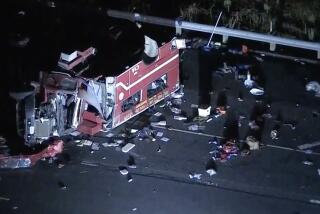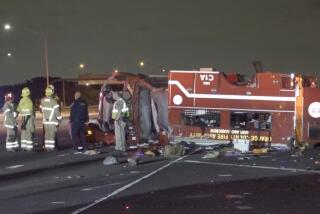Asiana passengers were told to stay in seats until attendant saw fire
SAN FRANCISCO — Passengers on Asiana Airlines Flight 214 were told to remain in their seats after the Boeing 777 slammed into the runway at San Francisco International Airport, with the evacuation beginning after a flight attendant spotted flames outside, officials said Wednesday.
National Transportation Safety Board Chairwoman Deborah A.P. Hersman told reporters that investigators on Tuesday interviewed six of the 12 flight attendants who were on board, who provided more details about the crash. Six flight attendants, including three who were ejected from the back of the jet, were still hospitalized and have not been interviewed.
The six attendants described Saturday’s initial impact followed by a second, Hersman said. After the plane came to a stop, the lead attendant asked another attendant “to go to the flight deck and ask the flight crew what to do.”
“The specific interest was, ‘Should we evacuate?’ ” Hersman said.
The flight crew told the attendant not to initiate an evacuation, saying that it was in communication with air traffic controllers. The lead attendant made an announcement over the public address system “for passengers to stay in their seats and not evacuate,” Hersman said.
Another attendant, located farther back on the left side, saw fire outside the window, Hersman said. He sent another attendant to the cabin to notify the flight crew, at which point the evacuation began.
Based on video evidence, two left doors opened about 90 seconds after the plane stopped and evacuation slides deployed, Hersman said. Passengers began leaving the plane via the slides and another door on the right side of the plane.
Two evacuation slides on the right side of the plane inflated inward, trapping two flight attendants, Hersman said. Investigators plan to examine the slides and the manufacturer has offered assistance in determining what went wrong, she added.
When asked if it was unusual that the crew wouldn’t announce the order to evacuate, Hersman said the pilots might not have been aware of the damage in the cabin.
“We don’t know what the pilots were thinking, but I can tell you, in previous accidents there have been crews that don’t evacuate,” she said. “They wait for other vehicles to come to get the passengers out safely. Certainly if there’s an awareness that there’s a fire aboard the aircraft, that is a very serious issue. There was a fire, and then the evacuation began.”
“Hindsight is 20/20,” she continued. “We all have a perspective that’s different than the people involved in this. We need to understand what they were thinking, what their procedures are, whether they complied with these, whether that evacuation proceeded in a timely manner.”
Two people were killed and 182 people were injured when the plane’s landing gear and tail struck a seawall at the end of Runway 28L. The investigation into the crash is ongoing.
ALSO:
‘Possible human remains’ found at missing Menifee boy’s home
Days after Asiana crash, FAA to require more training for co-pilots
Yosemite plan delayed amid clamor over curbing tourist amenities
More to Read
Sign up for Essential California
The most important California stories and recommendations in your inbox every morning.
You may occasionally receive promotional content from the Los Angeles Times.












